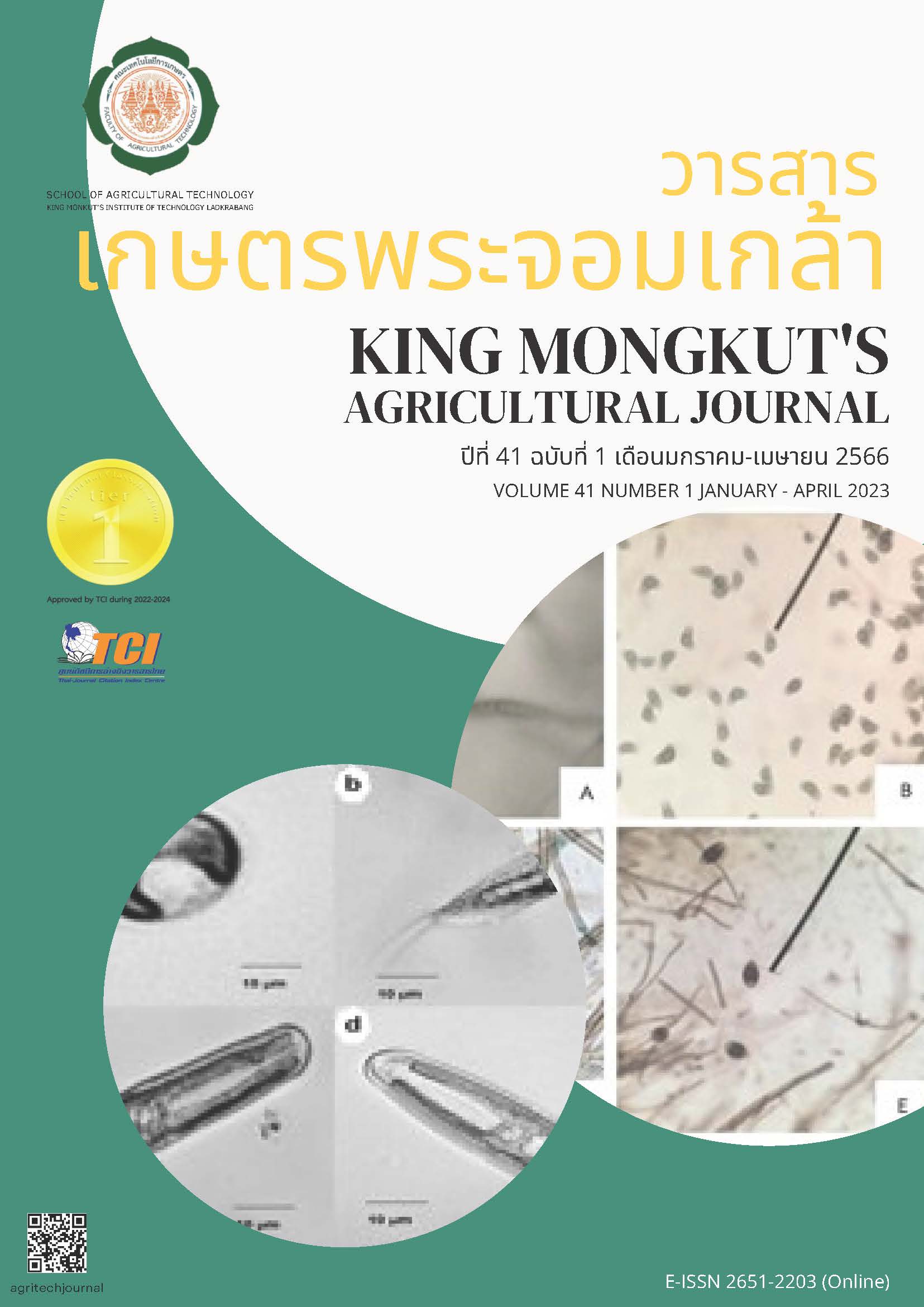ประสิทธิภาพของเชื้อราปฏิปักษ์ Trichoderma asperellum ในการควบคุมโรคที่เกิดจากเชื้อราบนใบของต้นกล้าปาล์มน้ำมัน
Main Article Content
บทคัดย่อ
การศึกษานี้ได้ทดสอบประสิทธิภาพเชื้อรา Trichoderma asperellum สายพันธุ์ NST-009 และ CB-Pin-01 ในการควบคุมโรคที่เกิดจากเชื้อราบนใบปาล์มน้ำมัน แยกเชื้อราโรคพืชจากใบต้นกล้าปาล์มน้ำมันด้วยวิธี Tissue transplanting technique ได้เชื้อราโรคพืชทั้งหมด 12 ไอโซเลท ได้แก่ Alternaria sp. 1 ไอโซเลท, Botryodiplodia spp. 2 ไอโซเลท, Colletotrichum spp. 2 ไอโซเลท, Curvularia spp. 3 ไอโซเลท, Drechslera spp. 2 ไอโซเลท และ Pestalotia spp. 2 ไอโซเลท ทดสอบการก่อโรคบนใบปาล์มน้ำมันด้วยวิธี detached leaf พบว่าทุกไอโซเลททำให้เกิดแผลขนาดเส้นผ่าศูนย์กลางในช่วง 2.3-4.1 มิลลิเมตร โดยเชื้อรา Curvularia sp.-03 เกิดแผลใหญ่สุดที่ 4.1 มิลลิเมตร และ Botryodiplodia sp.-01 เกิดแผลขนาด 3.5 มิลลิเมตร เมื่อทดสอบประสิทธิภาพเชื้อราปฏิปักษ์ในห้องปฏิบัติการพบว่าเชื้อราปฏิปักษ์ทั้ง 2 สายพันธุ์ สามารถยับยั้งและคลุมทับเส้นใยเชื้อรา Botryodiplodia sp.-01 และ Curvularia sp.-03 ได้ โดยเฉพาะ T. asperellum NST-009 ที่ยับยั้งและคลุมทับเชื้อราโรคพืชทั้ง 2 ชนิดสูงสุด โดยยับยั้งเชื้อรา Botryodiplodia sp. และ Curvularia sp. ได้ที่ระดับ 89.1 และ 84.9% ตามลำดับ และคลุมทับเชื้อราโรคพืชทั้ง 2 ชนิด ได้ที่ระดับ 67.4 และ 58.3% ตามลำดับ การทดสอบประสิทธิภาพเชื้อราปฏิปักษ์ในการควบคุมโรค พบว่าทั้ง 2 สายพันธุ์ สามารถลดความรุนแรงของโรคได้ โดย T. asperellum NST-009 ลดความรุนแรงของ Botryodiplodia sp.-01 และ Curvularia sp.-03 ได้ดีกว่า T. asperellum CB-Pin-01 อย่างมีนัยสำคัญ โดยพบโรคที่ 12.9 และ 17.1% ตามลำดับ ในขณะที่ T. asperellum CB-Pin-01 พบโรค 16.8 และ 25.5% ตามลำดับ ส่วนการตรวจปริมาณเชื้อรา Trichoderma spp. บนใบปาล์มน้ำมันพบว่าการใช้ T. asperellum NST-009 ตรวจพบมากสุดที่ 1.3×104 และ 2.3×104 CFU/ใบปาล์มน้ำมัน 1 กรัม ในการทดลองกับ Botryodiplodia sp.-01 และ Curvularia sp.-03 ตามลำดับ
Article Details

อนุญาตภายใต้เงื่อนไข Creative Commons Attribution-NonCommercial-NoDerivatives 4.0 International License.
วารสารเกษตรพระจอมเกล้า
เอกสารอ้างอิง
Chamswarng, C. (2020). Trichoderma: antagonistic fungus for plant disease control. Bangkok: Kasetsart University. (in Thai).
Chamswarng, C., Yenjit P., & Intana W. (2012). Fungal disease control and quality during storage of rambutan (Nephelium lappaceum L. cv. Rong Rien) fruits treated with Trichoderma harzianum and chelated calcium at preharvest. Journal of Philippine Agricultural Scientist. 96(4), 377-383.
Charoenrak, P. & Chamswarng, C. (2015). Application of Trichoderma asperellum fresh culture bioproduct as potential biological control agent of fungal diseases to increase yield of rice (Oryza sativa L.). Journal of International Society for Southeast Asian Agricultural Sciences. 21(2), 67-85.
Eksomtramage, T. & Jantaraniyom, T. (2015). Oil Palm Handbook. Songkhla: Hatyai Digital Print. (in Thai).
Harman, G. E., Howell, C. R., Viterbo, A., Chet I., & Lorito, M. 2004. Trichoderma speices opportunistic, avirulent plant symbionts. Nature Reviews Microbiology. 2, 43-55.
Intana, W., Wonglom, P., Suwannarach, H., Lumyong, S., & Sunpapao, A. (2021). Biotic Stress by Trichoderma asperelloides PSU-P1 Induced Pathogenesis Related Proteins Genes Expression Against Gummy Stem Blight in Muskmelon (Cucumis melo). Journal of Fungi. 7, 01-13.
Kittimorakul, J., Pornsuriya, C., Sunpapao, A., & Petcharat, V. (2013). Survey and incidence of leaf blight and leaf spot diseases of oil palm seedlings in southern Thailand. Journal of Plant Pathology. 12, 149-153.
Kumar, H. (2018) Evaluation of Different Fungicides for the Control of Die-Back Disease of Rose Caused by Botryodiplodia theobromae Pat. In vitro. Journal of Pure and Applied bioscience. 6(2), 801-805.
Malkanthi A. G. I., Perera R. A. S., & Dissanayake M. L. M. C. (2016). Turf Yellowing Disease in Paspalum vaginatum (Turf Grass): Identification of Causative pathogen and Chemical Control. Journal of Agricultural Scientist. 11(2), 130-136.
Pornsuriya, C., Sunpapao, A., Srihanant, N., Worapattamasri, K., Kittimorakul, J., Phitakkit, S., & Petcharat, V. (2013).
A survey and diseases and disorders in oil palm of southern Thailand. Journal of Plant Pathology. 12, 169-175.
Promwee, A., Issarakraisila, M., Intana, W., Chamswarng, C., & Yenjit, P. (2014). Phosphate Solubilization and Growth Promotion of Rubber Tree (Hevea brasiliensis Muell. Arg.) by Trichoderma Strains. Journal of Agricultural Scientist. 6(9), 8-20.
Promwee, A., Yenjit, P., Issarakraisila, M., Intana, W., & Chamswarng, C. (2017). Efficacy of indigenous Trichoderma harzianum in controlling Phytophthora leaf fall (Phytophthora palmivora) in Thai rubber trees. Journal of Plant Diseases and Protection. 124(1), 41-50.
Sunpapao, A., Kittimorakul, J., & Pornsuriya, C. (2014). Disease Note: Identification of Curvularia oryzae as cause of leaf spot disease on oil palm seedlings in nurseries of Thailand. Phytoparasitica. 42, 529-533.
Sunpapaoa, A., Chairina, T., & Ito, S.I. (2018). The biocontrol by Streptomyces and Trichoderma of leaf spot disease caused by Curvularia oryzae in oil palm seedlings. Journal of Biological Control. 123, 36-42.
Tapwal, A. & Pandey, H. (2016). In vitro evaluation of Trichoderma species for virulence efficacy on Botryodiplodia palmarum. Journal of Current Life Sciences. 2(3), 86-91.


